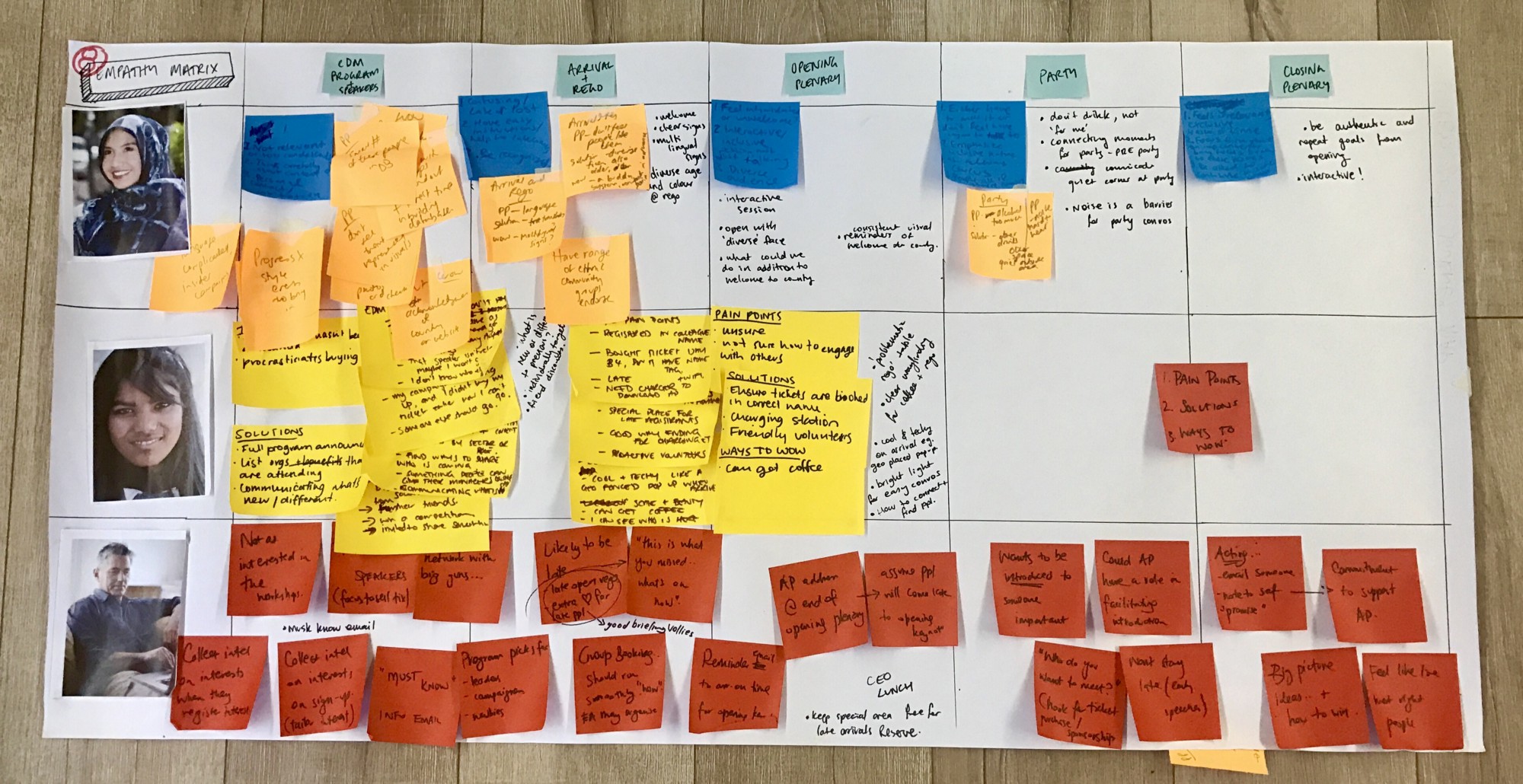The making of a meaningful micro experience
A guest experience volunteer at Purpose 2016. Photo: Myf Garven
I was recently talking to a friend who is a brilliant creative producer at one of the most popular and loved music festivals in Australia.
As she spoke about some of the pains and annoyances she has had with sponsors or others who try to influence the design of the festival’s components, she lamented that they think she’s being ‘difficult’ for insisting on oversight of low-level things such as how their menu cards at the bar look and feel, or exactly how their logo is shown within an activated space. “What they don’t understand..”, she said, “is that it’s the tiny details; the lighting, the rug under foot, the smile from a bartender, that people don’t consciously register.. which combine to create a feeling of magic when someone walks into that space”. And straight away I understood.
Once the details slip, the minute the magic is interfered with, she and her team could lose everything that makes their festival loved and sold out year-on-year. And, in fact, they would jeopardise the authentic experience that their audience values which is what makes the sponsor want to be there in the first place.
In the design of technology, the ultimate goal is to achieve a frictionless experience which is positive, solves a problem, makes the user’s life easier and becomes a new habit. That way, their loyalty to the product is tied to their subconscious understanding; ‘this is the best, and only, solution to my needs’. Micro interaction has long been a focus of digital UX design.
In the design of real world experiences and touch points, the kind of experiences that are considered the holy grail are not just those which are frictionless or not negative, but are intensely positive. Such an experience is achieved by creating meaning for that individual and/or an absolutely unique moment. These are the kind of experiences that have people telling their friends how brilliant something was for months or years.
One of the ways to create such an intimate exchange is through micro experience design.
A micro experience is most often a small, subtle, affordable and memorable touch that resonates with your customers for years. Not difficult to achieve, but challenging to design into the behaviour of a whole team or organisation. When it comes to these experiences, which are made up of meaning as well as personalisation, we’re not talking about experiences that can be crafted by a design team and then rolled out throughout an organisation (by definition anything that’s created en masse or applied generally cannot be unique), what we’re most often talking about with micro experiences is those that are designed and executed at ground level.
Guest welcome at Link Festival 2016
In order for these experiences to take place, they need to be designed for and orchestrated, not dictated. They are often also a matter of culture and training, rather than a matter of customer service ‘scripts’, or imposed behaviour such as acceptable styles of staff haircut. These experiences happen when team members take the customer’s journey into their own hands, feel responsible for it, and lift the experience as they would in a scenario where they’re intrinsically motivated to do so — helping a family member with something challenging or showing hospitality to a friend.
The idea of micro experience has come up frequently for the team and I at Wildwon and is a common theme in much of our work and research.
Consider the rise of the micro-influencer — social media personalities with a small following and niche interest have more potent engagement and influence. Greta Rose van Riel, who has built multiple multi-million dollar e-commerce businesses focusses the bulk of her attention on micro influencers, those who might not necessarily have a huge following or social reach, but have much higher levels of trust and engagement with their audiences. Look also at the micro moment, a focus for content marketing and e-commerce, where persuasion over split-second decisions are the key to manipulating conversion rates and sales. (Thank you to The Office Space’s Naomi Tosic for the excellent posts above, whose own focus on micro moments has won The Office Space ‘Best workplace in the world’).
The Office Space at Paramount House, Sydney. Photo: Broadsheet
AirBnb apartment in Tokyo, Japan
Consider also the success of AirBnB who have been known to invest heavily in the use of anthropologists and ethnographers to design boththeir brand and inform the customer’s experience on both sides of their marketplace (hosts and guests), ensuring that it is culturally appropriate down to the finest detail. Looking in particular at how they engage with potential users when entering a new country, for them, nothing can be left to chance when it comes to gaining the trust and intimacy required to rent and enter people’s homes. They invest in an intimate understanding of cultural sensitivities in the design of their interactions with hosts. For them it’s not about consistency of every touch point across borders, as with multi-nationals of days gone by. Rather, they know that Airbnb’s success lies in how well they can inspire hosts to be their proxy micro experience designers, creating unique experiences in each property.
I have long subscribed to the philosophy of the upside down marketing funnel, a term coined by Mailchimp co-founder Ben Chestnut which flips the traditional ‘marketing funnel’ on its head. The upside down funnel says that it’s not about shallow levels of interaction with a mass audience, or chasing down people you don’t know yet, but instead treating the customers you already have like royalty. The theory goes that the word of mouth generated by a strongly positive interaction will mean that your first 1000 customers will win you your next 1000, and so on and so forth as the funnel widens outwards.
Not only are micro experiences the key to deep, ongoing engagement and loyalty, they are an important marketing activity — because they create the kind of enthusiasm that the upside down marketing funnel relies on.
For Wildwon, we’re interested in both smooth, frictionless and pleasant experiences, as well as the kind of deep, meaningful and unique experiences that we believe can change hearts and minds.
These experiences need to be designed for and orchestrated. We have a number of methodologies and tools for doing this, however here are our top tips for creating the kind of exceptional micro experiences I’m talking about.
Tips for creating exceptional micro experiences:
- Empower teams to be creative in personalising an experience, and adding their personality to an exchange. If you want to guide them on the kinds of experiences they are trying to create, use experience design principles (see below), rather than dictating a script or set of activities that can make an exchange seem robotic and impersonal
- Use experience design (XD) principles to guide the overarching parameters within which people can ‘free style’ and have autonomy to be creative and personal. An XD principle might be something like: “make me feel welcomed to the point of ‘Wow’”, “remember I’m a human”, “make the everyday extraordinary” or “make things easy for me”. Note these are in the voice of the user to create instant empathy and are simple enough for anyone to understand and apply their judgement to
- Remember that no experience is too small to focus on. One of our favourite websites is “Little Big Details” which brings into focus just how integral the micro experience is in digital UX and design. The same emphasis should exist for all customer experiences. The opportunity to surprise and delight is only greater in the fine grain moments that people assume no-one will put a great deal of thought into
- Ask for feedback and broaden the parameters. Pay attention to things that may be outside your focus or seem beside the point. A recent example comes to mind of walking around a gallery where the timber floors were loose and creaking. It was quite loud and broke the peace of the contemplative environment otherwise characteristic of a gallery visit. The experience would have been vastly improved by replacing the floors but this may not come up in a typical feedback survey about the artwork or guided tours
- Invest in training and development opportunities for teams that bring them across the philosophy and principles you wish to have applied to the customer’s experience — eg. human and unique — rather than training in dictated service scripts or manuals
A quick and rough empathy matrix with personas the team were familiar with
- Map experiences and customer journeys. The only way to systematically anticipate negative experiences and design for positive ones is to use experience maps to guide your design and preparation. But these don’t have to be sophisticated. If you don’t have the resources to invest in extensive research, persona development or customer journey mapping, a tool we’ve developed is called an ‘Empathy Matrix’. It is, simply, a matrix of 5 key most important moments (as defined by project team or users themselves) across one axis and 3–4 key personas down another. What might frustrate, relieve or wow at the intersection of persona A + moment B?
A vision board of key moments in the 3-day journey of an event
- Alternatively, map or take note of every item that will be looked at, read, touched, heard, seen and think about how each one of those experiences is a touch point for you and your user. Even more simple, a vision board can be created for each of the key moments in your user’s journey.
- For deeply positive experiences, think of visceral and sensory interventions you can make. Temperature, scent, taste, lighting or sound are often the best tools to create a sense of deep comfort, familiarity, warmth or happiness — shopping centres have been known to pump the scent of flowers or apple and cinnamon into spaces to induce happiness or hunger. At an event, warm lighting can create an entirely different sensory and energetic experience to fluorescent. Fresh air can feel very different to stale or conditioned air. Aesop famously wash and therefore touch the hands of customers who enter the store — creating an instant personal connection to the sales assistant, the store and the product.
And why are we at Wildwon so intent on people having positive experiences? Because we’re in the business of creating positive social change. And because our work tells us that when people have a positive experience of something — whether that’s a community, behaviour or product — they continue to come back to it.
To add to this, in the words of David Attenborough:
“No-one will protect what they don’t care about and no-one will care about what they haven’t experienced”.
This is what is, to us, important about the art of experience design. We are here to craft experiences — with organisations, ideas or products - that are so positive that people can’t help but deeply connect and care.
This post was originally published on Medium on May 28, 2017








